Australia, US and allies launch COVID vaccine plan for Asia
Scott Morrison is one of three world leaders invited to ramp up vaccine supply in Asia as ties with China weaken.
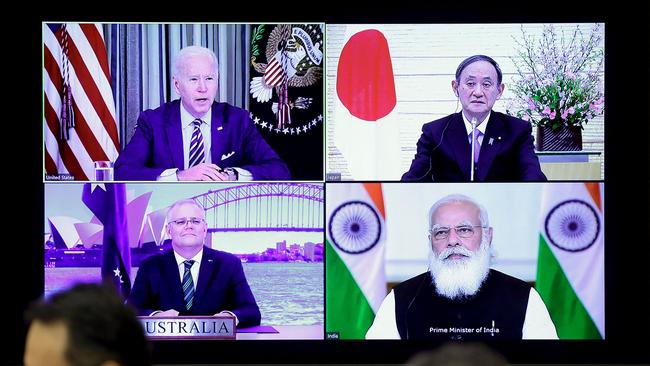
World
Don't miss out on the headlines from World. Followed categories will be added to My News.
Australia, the United States, India and Japan have launched a joint drive to ramp up the COVID-19 vaccine supply in Asia, mounting a challenge to China in the first-ever summit of the four democracies.
In a virtual meeting held on Friday between the US and the three nations, US President Joe Biden, who has vowed to reinvigorate alliances in the face of growing worries about China, spoke for around 90 minutes with the three nations’ prime ministers.
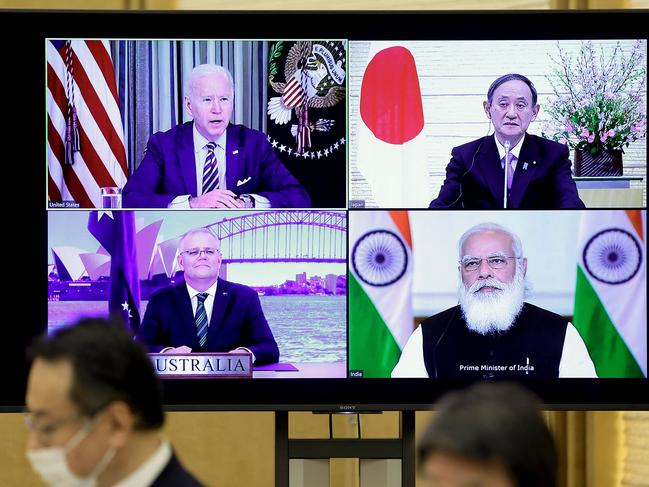
US officials said the so-called “Quad” nations have agreed to work together to produce up to one billion vaccine doses by 2022 as the world seeks to turn the page on the devastation of the COVID-19 pandemic.
The plan will see pharmaceutical hub India manufacturing the single-dose vaccine from US-based Johnson & Johnson backed by financial support from Japan, with Australia taking charge of shipments.
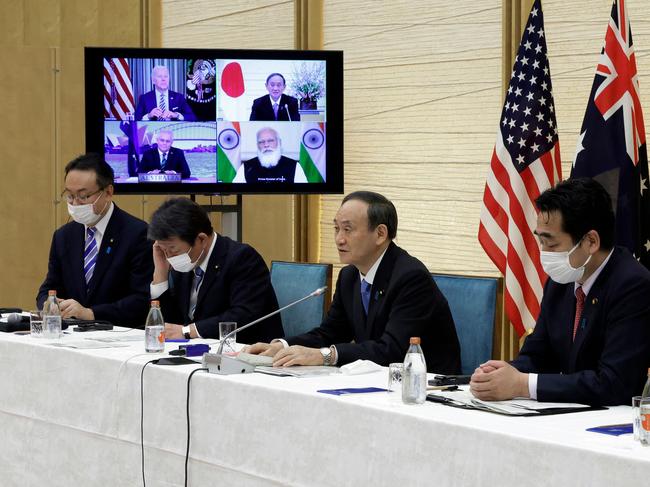
The meeting began shortly after 8:30am local time (12:30am AEDT).
Three tables were set in a horseshoe formation, with Mr Biden at the centre table flanked by Secretary of State Anthony Blinken and Vice President Kamala Harris.
Prime Minister Narendra Modi of India, Prime Minister Scott Morrison of Australia, and Prime Minister Yoshihide Suga of Japan were featured on large flat screen televisions to the left of the Mr Biden, adjacent to flags from their corresponding nations.
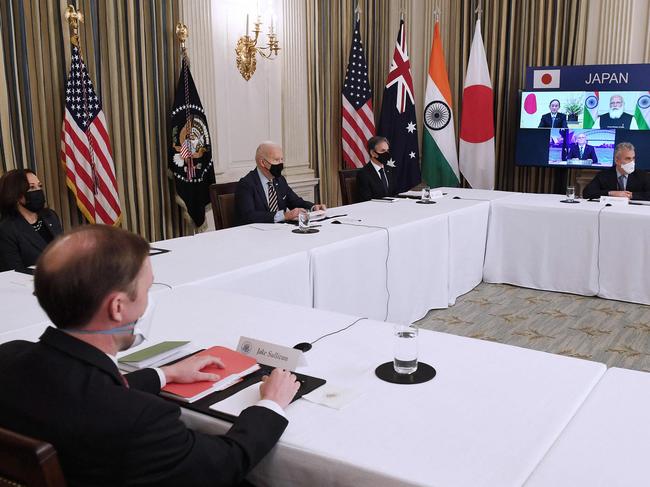
Attending the Quad meeting in person were Jake Sullivan, National Security Advisor, Jeff Zients, Coordinator of the US COVID-19 Response, Kurt Campbell, Indo-Pacific Coordinator, National Security Council and Sumona Guha, Senior Director for South Asia, National Security Council.
During the meeting Mr Biden announced: “We’re renewing our commitment to ensure that our region is governed by international law, committed to upholding universal values and free from coercion.”
“A free and open Indo-Pacific is essential,” said Mr Biden, implicitly referring to China’s growing dominance in the region.
“The United States is committed to working with you, our partners, and all of our allies in the region to achieve stability. This is a group particularly important because it is dedicated to the practical solutions and concrete results,” he said.
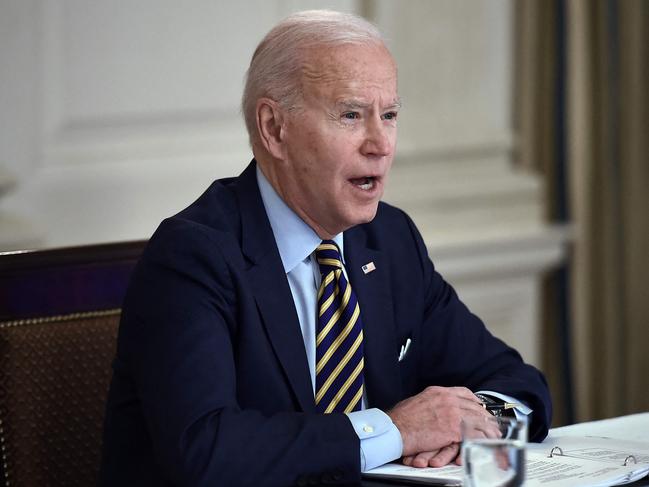
Pledging that the Quad should bring “practical solutions and concrete results,” Mr Biden said, “We’re launching an ambitious new joint partnership that is going to boost vaccine manufacturing for the global benefit and strengthen vaccinations to benefit the entire Indo-Pacific.”
US officials said the initiative would produce up to one billion vaccine doses by 2022 as the world seeks to turn the page on the devastation of the COVID-19 pandemic.
“We’ve got a big agenda ahead of us gentlemen as you well know, but I’m optimistic about our prospects. The Quad is going to be vital in our cooperation in the Indo-Pacific and I look forward to looking closely to working with all of you in the coming years.”
The other world leaders expressed similar excitement and willingness to collaborate in the Indo-Pacific region.
China over the past year has engaged in a deadly clash with Indian forces in the Himalayas, stepped up activity near islands administered by Japan and imposed sanctions on Australian products following a series of disputes.
Australian Prime Minister Scott Morrison said that the summit marked “a new dawn in the Indo-Pacific.”
“As four leaders of great liberal democracies in the Indo-Pacific, may our partnership be the enabler of peace, stability and prosperity, and to do so inclusively with the many nations of our region,” Mr Morrison said.
WHAT IS THE QUAD?
The Quadrilateral Security Dialogue format has been growing for more than a decade, but these talks are the first at the leaders’ level and come as all four democracies see relations with China deteriorate.
China over the past year has engaged in a deadly clash with Indian forces in the Himalayas, stepped up activity near islands administered by Japan and imposed sanctions on Australian products following a series of disputes.
The Biden administration, however, has been careful not to link the Quad explicitly to China — a shift in rhetoric after former president Donald Trump’s strident denunciations of Beijing.
State Department spokesman Ned Price said that the Quad is not focused “on any single issue”.
“We have shared interests in standing up for universal values and rights. We have shared economic interests. We have shared security interests. We have deep people-to-people ties with all of these countries,” Price said.
Australian Prime Minister Scott Morrison, said that China should not be concerned by the talks.
The Quad, Morrison told reporters, is about “liberal democracies standing up for our values, coming together and ensuring that we are an anchor for peace and stability in the Indo-Pacific.”

The Biden administration has said alliances – many of which were badly rattled by the vitriolic Trump – will be key in achieving its goals.
Earlier this month, the White House cast China as its top challenger and said the United States can help counter Beijing’s “aggression” by “bolstering and defending our unparalleled network of allies and partners.”
The Quad summit kicked off a flurry of such diplomacy.
But China’s state-run Global Times newspaper criticised the Quad summit as a US plot against Beijing, saying in an opinion piece that India – which has rapidly warming relations with the United States but is not a treaty-bound ally – should have maintained a distance.
“The Quad is not an alliance of like-minded countries as the US claims,” the newspaper said, opining that the three other nations face “the embarrassment of being between the pressure from the US and their own interests with China.”
ITALY LOCKS DOWN AGAIN
Italy’s government is expected to announce the closure of schools, restaurants and shops across most of the country to counter what experts warned was a third wave of coronavirus.
Prime Minister Mario Draghi’s cabinet agreed new guidelines for restrictions in the eurozone’s third-largest economy, which on Thursday recorded almost 26,000 new COVID-19 cases and 373 deaths.
From Monday, every region with more than 250 cases per 100,000 inhabitants would pass automatically into the highest risk “red zone”, a spokesman for Draghi’s office said.
The latest official data is expected later Friday, but figures from the GIMBE think tank published Thursday for the week ending 9 March suggest the majority of regions will turn red.
Mr Draghi’s office also confirmed that all of Italy would be in a red zone over Easter weekend, between 3 and 5 April.

Previously, the classification of red zones was designated based on a range of criteria, involving some political input.
In these areas, schools, bars, restaurants, shops and museums must close, and residents are only permitted to leave home for work, health or other essential reasons.
Media reports had suggested Italy’s more populated northern regions such as Lombardy, which includes Milan, would be among those going into the red, as would Lazio, which includes Rome.
The new restrictions, on top of the existing 10:00 pm to 5:00 am curfew in place across Italy, will last until Easter.
More than 100,000 people with coronavirus have died in Italy since the pandemic swept over the country one year ago, sparking a months-long lockdown and triggering the worst recession since World War II.
Cases are on the rise once again, fuelled by new, more contagious variants.
Italy began its coronavirus vaccination campaign in late December but as elsewhere in Europe, it has been dogged by delays in deliveries of the jabs.

SEVERE ALLERGY ADDED TO ASTRA SIDE EFFECTS
Severe allergies should be added to the possible side effects of AstraZeneca’s coronavirus vaccine after likely links were found to a number of cases in Britain, the EU’s drug regulator said on Friday local time.
The development comes a day after the European Medicines Agency said it was investigating a separate issue of blood clots that prompted Denmark to suspend use of the jab, but said it remained safe to use.
The Amsterdam-based EMA said it had “recommended an update to the product information to include anaphylaxis and hypersensitivity (allergic reactions) as side effects”.
“The update is based on a review of 41 reports of possible anaphylaxis seen among around 5 million vaccinations in the United Kingdom,” it said in the highlights of the EMA committee that assesses the risk of medications.
“After careful review of the data, (the committee) considered that a link to the vaccine was likely in at least some of these cases.” The EMA said however that anaphylaxis, or what it called “severe allergic reactions”, was already what it called a “known side effect that may occur, very rarely, with vaccines”.
The AstraZeneca vaccine’s product information already said that people should be kept under “close observation for at least 15 minutes” after getting the jab in case of allergic reactions.
Read related topics:Scott Morrison




